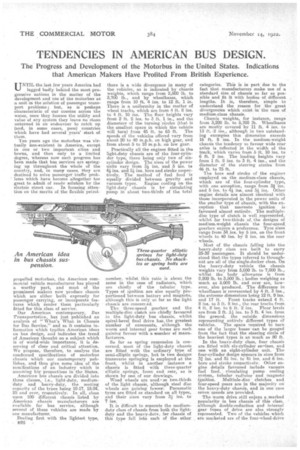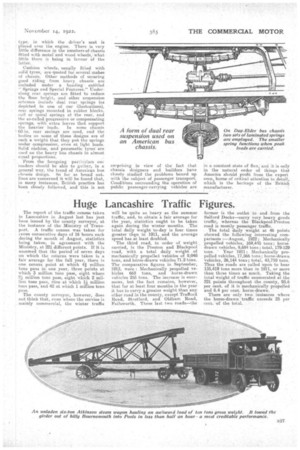TENDENCIES IN AMERICAN BUS DESIGN.
Page 10

Page 11

If you've noticed an error in this article please click here to report it so we can fix it.
The Progress and Development of the Motorbus in the United States. Indications that American Makers Have Profited From British Experience.
UNTIL the last few years America had lagged badly behind the most progressive nations in the matter of the development and use of the motorbus as a unit in thasolution of passenger transport problems ; but, as is peshaps characteristic of our cousins across the water, once they foresee the utility and value of any system they leave no stone unturned in an endeavour to catch up (and, in some cases, pass) countries which have had several years' start of t h cm , Ten years ago the motorbus was virtually non-existent in America, except in one or two important cities and towns, and then only to a limited degree, whereas now such progress has been made that bus services are springing up throughout; the whole of the country, and, in many cases, they are destined to solve passenger traffic problems which have become altogether too great to admit of ready solution by the electric street car. In focusing attention on the merits of the flexible petrol propelled motorbus, the American commercial vehicle manufacturer has played a worthy part, and most of the prominent makers now produce chassis which are either built expressly for passenger carrying, or incorporate features which render them particularly -fitted for this class of service.
Our American contemporary, Bus Transportation, has just published an analysis of " What's What in Chassis for Bus Service," and as it contains information which typifies American ideas on bus design, and indicates the trend of American thought. on a subject which is of world-wide importance, it is deserving of close and critical attention. We propose, therefore, to analyse the condensed specifications of motorbus chassis which our contemporary publishes, and thus give some idea of the ramifications of an industry which is assuming big proportions in the States.
American bus chassis are divided into three classes, i.e., light-duty, medians'duty and heavy-duty, the seating capacity of the types being 10-17, 18-24, 25 and over, respectively. In all, close upon 100 different chassis listed by American chassis manufacturers are available for bus service, although several of these vehicles are made by one manufacturer.
Dealing first with the lightest type, there is a wide divergence in many of the vehicles, as is indicated by chassis weights, which range from 2,500 lb. to 3,700 lb., and by wheelbases, which range from 10 ft. 4 ins. to 12 ft. .1 in. There is a uniformity in the matter of wheel tracks, which are from 4 ft. 8 ins. to 4 ft. 10 ins. The floor heights vary ficoni 2 ft. 2 ins. to 3 ft. 1 in., and the diameters of the turning circles (that is the smallest space in which the vehicle will turn) from 45 ft. to 65 ft. The speeds of the vehicles offered vary from about 20 to 40 m.p.h. on high gear, and from about 5 to 10 m.p.h. on low gear.
Practically all the engines fitted in the light-duty chassis are of the fonr-cylinder type, there being only two of sixcylinder design. The sizes of the power units vary from si ins. and 5 ins. ta 4-& ins, and 5i ins, bore and stroke respectively. The method of fuel feed equally divided between gravity and vacuum types. Engine cooling on the light-duty chassis is by circulating pump in about two-thirds of the total
number, whilst this ratio is about the same in the case of radiators, which are chiefly of the tubular type. Types of ignition are also equally proportioned between battery and magneto, although this is only an far as the light chassis are concert ed, The three-speed gearbox and the multiple-disc clutch are chiefly favoured in the light-duty bus chassis, whilst spiral-bevel final drive has, the greatest number of exponents, although the worm and internal gear forms are each gaining favour with a number of manufacturers.
So far as spring suspension is concerned, most of the light-duty chassis are fitted with the ordinary tsrpe of semi-elliptic springs, but in two designs transverse springing is employed at the front, whilst in another instance a chassis is fitted With three-quarter elliptio springs, front and rear, as is shown by one of our drawings.
Wood wheels are used osn two-thirds of the light chassis, although steel disc wheels are gaining favour. Pneumatic tyres are fitted as standard on all types, and their sizes vary from 3i ins. to 7 ins.
It is difficult to separate the medium. duty class of chassis from both the lightduty and the heavy-duty, for chassis of this type fall into each of the other categories. This is in part due to the fact that manufacturers make use of a standard Size of chassis so far as pos sible and fit it with bodies of different lengths. It is, therefore, simple to understand the reason for the great divergencies which exist in the case of merliurnsclass chassis.
Chassis weights, for instance, range from 3,200 lb. to 5,700 lb. Wheelbases are mostly covered by 11 ft. 4 ins. to 13 ft. -2 ins., although in two outstanding examples this dimension exceeds 16 ft. 8 ins. In the medium-weight chassis the tendency to favour wide rear axles is reflected in the width of the track, which varies from 5 ft. 10 ins. to 6 ft. 2 ins. The loading heights vary from 1 ft. 8 ins. to 3 ft. 4 ins., and the diameter of the steering circles from 46 ft, to 75 ft.
The bore and stroke of the engines employed on the medium-class chassis, which are of the four-cylinder type, ins. and one exception, range from 3i and 5 ins. to 44 ins. and 5i ins. Other engine details are almost identical with those incorporated in the power units of the smaller type of chassis, with the ex ception that magneto ignition is favoured almost entirely. The multiple. disc type of clutch is welt represented, whilst for two-thirds of. the designs of medium-weight chassis the four-speed gearbox enjoys a preference. Tyre sizes range from 34 ins. by 5 ins. on the. front wheels to 40 ins. by 8 ins. on the rear wheels.
Most of the chassis falling into the heavy-duty class are built to carry 25-30 passengers. It should be under stood that the types referred to throughMit are all of the single-decker class. On the heavy-duty vehicle the chassis weights vary from 5,000 lb. to 7,000 lb., whilst thc body allowance is from 2,200 lb. to 3,500 lb. ; bodies weighing as much as 5,000 lb. and over are, however, also produced. The difference in svheelbases ii represented by 4 ft. 3 ins., the extreme dimensions being 12 ft. 9 ins.
and 17 ft. Front tracks extend 4 ft.
8 ins. to 5 ft. 8 ins., the rear tracks from.
4 ft. 8 ins. to 6 ft. 2 ins. Floor levels are from 2 ft. 11 ins. to 3 ft. 4 ins, from the ground, the outside dimensions representing entii•ely different types of vehicles. The space required to turn one of the larger buses can be gauged from the fact that the steering circle of the heaviest types is as much as 80 ft..
In the heavy-duty class, four chassis are fitted svith six-cylinder enrines, and one with an eight-cylinder unit. The four-cylinder design appears in sizes from 51 ins. and .5; iss. to 44 ins, and .6 ins.
bore and stroke respectively. Other engine details favoured include vacuum fuel feed, circulating pump cooling system, tubular radiator and magneto: ignition. Multiple-disc clutches and four-speed gears are in the majority on the heavy-elisty chassis, and in one case seven speeds are provided.
The worm drive still enjoys a marked popularity in bus chassis of this class. although double-reduction and internal gear types of drive are also strongly represented. Two of the vehicles which are marketed are of the four-wheel-drive type, in which the . driver's seat is placed over the engine. There is very little difference in the numbers of chassis fitted with metal andwood .wheels, what little there is being in favour of the latter.
CuShion wheels, usually fitted with solid tyres, are quoted for several makes of chassis. Other methods of securing good riding from heavy chassis are included under a heading entitled " Springs and Special Features." Underslang seat springs are fitted to reduce the floor height, 'and other suspension schemes intlude dual rear springs his depicted in one of our illustrations), rear springs mounted in rubber blocks, coil or spiral springs at the rear, and the so-called progressive or compensating springs, with extra leaves that. support
the heavier loads. In some chassis 60-in, sear springs are used, and the bodies 00 some of these designs are of such a weight that they put the springs under eompression, even at light loads. Solid cushion; and pneumatic tyres are used On the heavy bus chassis in almost equal proportions.
From the foregoing partisalars our readers should be able to gather, in a general way, the trend of American bus chassis design. So far as broad outlines are concerned it will be found that, in many instances, British practice has been closely followed, and this is not surprising in view of the fact that chassis designers and builders have closely studied the problems board up with tho subject of passenger transport. Conditions surrounding the operation of public passenger-carrying vehicles are in a constant state of flinx; and it is wily in the natural order of. things that America should profit from the experi ence, borne of critical attention to detail, which is the heritage of the British manufacturer.. • '
































